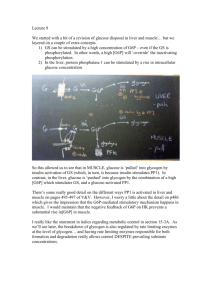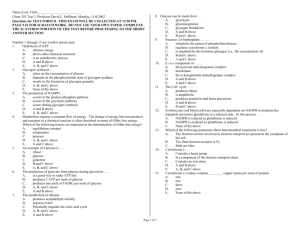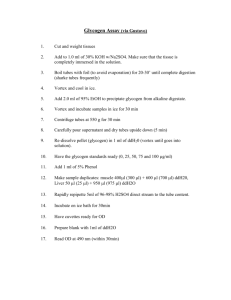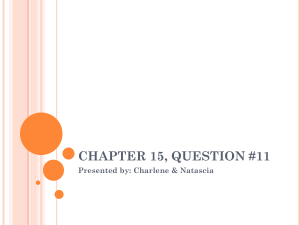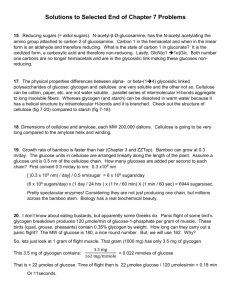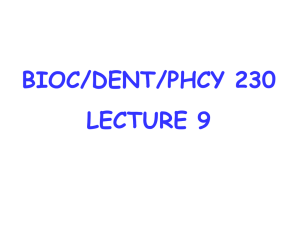Glycogen Synthesis and Degradation
advertisement
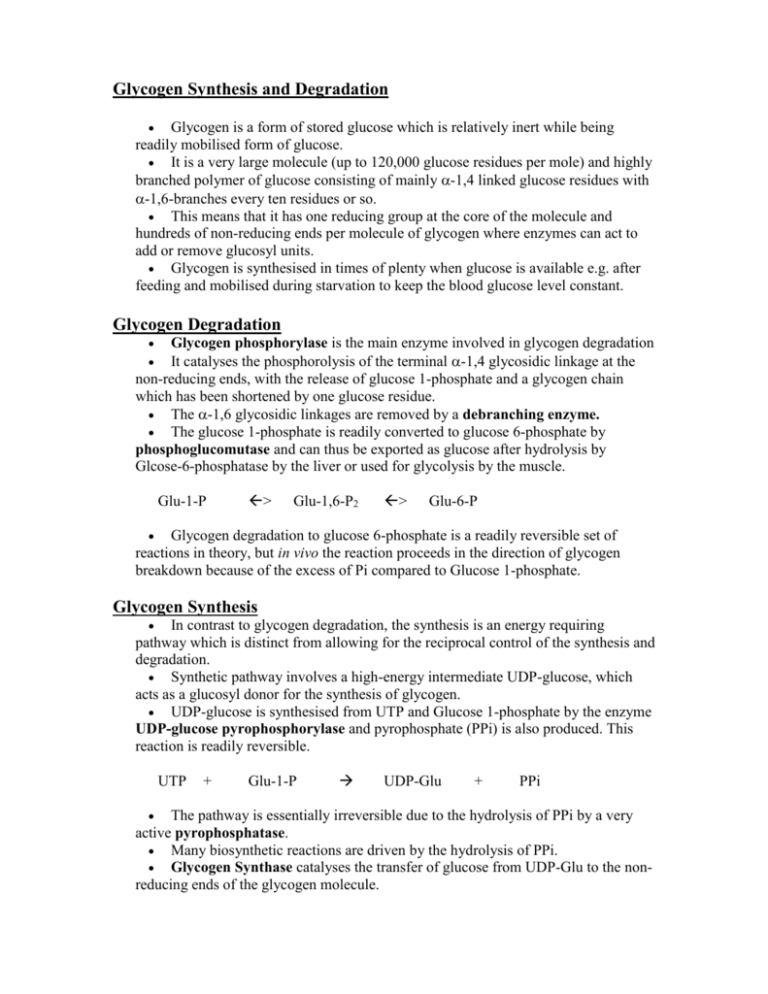
Glycogen Synthesis and Degradation Glycogen is a form of stored glucose which is relatively inert while being readily mobilised form of glucose. It is a very large molecule (up to 120,000 glucose residues per mole) and highly branched polymer of glucose consisting of mainly -1,4 linked glucose residues with -1,6-branches every ten residues or so. This means that it has one reducing group at the core of the molecule and hundreds of non-reducing ends per molecule of glycogen where enzymes can act to add or remove glucosyl units. Glycogen is synthesised in times of plenty when glucose is available e.g. after feeding and mobilised during starvation to keep the blood glucose level constant. Glycogen Degradation Glycogen phosphorylase is the main enzyme involved in glycogen degradation It catalyses the phosphorolysis of the terminal -1,4 glycosidic linkage at the non-reducing ends, with the release of glucose 1-phosphate and a glycogen chain which has been shortened by one glucose residue. The -1,6 glycosidic linkages are removed by a debranching enzyme. The glucose 1-phosphate is readily converted to glucose 6-phosphate by phosphoglucomutase and can thus be exported as glucose after hydrolysis by Glcose-6-phosphatase by the liver or used for glycolysis by the muscle. Glu-1-P > Glu-1,6-P2 > Glu-6-P Glycogen degradation to glucose 6-phosphate is a readily reversible set of reactions in theory, but in vivo the reaction proceeds in the direction of glycogen breakdown because of the excess of Pi compared to Glucose 1-phosphate. Glycogen Synthesis In contrast to glycogen degradation, the synthesis is an energy requiring pathway which is distinct from allowing for the reciprocal control of the synthesis and degradation. Synthetic pathway involves a high-energy intermediate UDP-glucose, which acts as a glucosyl donor for the synthesis of glycogen. UDP-glucose is synthesised from UTP and Glucose 1-phosphate by the enzyme UDP-glucose pyrophosphorylase and pyrophosphate (PPi) is also produced. This reaction is readily reversible. UTP + Glu-1-P UDP-Glu + PPi The pathway is essentially irreversible due to the hydrolysis of PPi by a very active pyrophosphatase. Many biosynthetic reactions are driven by the hydrolysis of PPi. Glycogen Synthase catalyses the transfer of glucose from UDP-Glu to the nonreducing ends of the glycogen molecule. Glucosyl unit is transferred to the C-4 in the terminal glucose residue to form an -1,4 glycosidic linkage. Branching enzyme (a different protein to debranching enzyme) breaks an 1,4 glycosidic and transfers the resultant oligosaccharide which is then attached via an -1,6 glycosidic linkages at regular intervals in the glycogen. Branches are created by transferring blocks of 7 glucosyl residues to the C6 hydroxyl of a glucose unit in an adjacent chain. Each oligosaccharide block of 7 residues must come from a linear chain of at least 11 -1,4 glucosyl residues and the new branch point must be at least 4 residues away from another branch point In plant starch (amylopectin) which has a comparable structure to glycogen, although with fewer branch points, ADP-glucose is the main high energy glucosyl donor. Glycogenin BS2510 -2004 In a number of purification schemes for the isolation of glycogen synthase (86 kDa) from muscle it has proved very difficult to separate a tightly bound contaminating protein which forms a 1:1 mole/mole complex with GS It turned out that this protein (Glycogenin) had an important function in the initiation of glycogen synthase It has glycogen synthase –like activity and is capable of auto-glycosylation, the transfer of Glucose from UDP-Glu to a Tyr194 residue within the protein Glycogenin then transfers a further 7 Glucosyl residues The reactions are autocatalytic (ie catalysed by glycogenin itself) until the oligosaccharide grows to 8 units at which point Glycogen Synthase and Branching Enzyme take over The glycogenin remains buried at the core of each glycogen molecule. Glycogen Synthase is incapable of de novo glycogen synthesis Muscle glycogenin can be distinguished from Glycogen Synthase because of the different MWt, a higher affinity for UDP-Glu,and the fact that it requires Mn2+ for activity Now cloned and expressed in E.Coli and shown to be capable of autoglycosylation and the initiation of glycogen synthesis Two forms of glycogenin have been found in mammalian systems o Glycogenin 1 (37 kDa form with a broad tissue distribution, inc. muscle) o Glycogenin 2 (50 – 55 kDa in liver, pancreas and heart)
